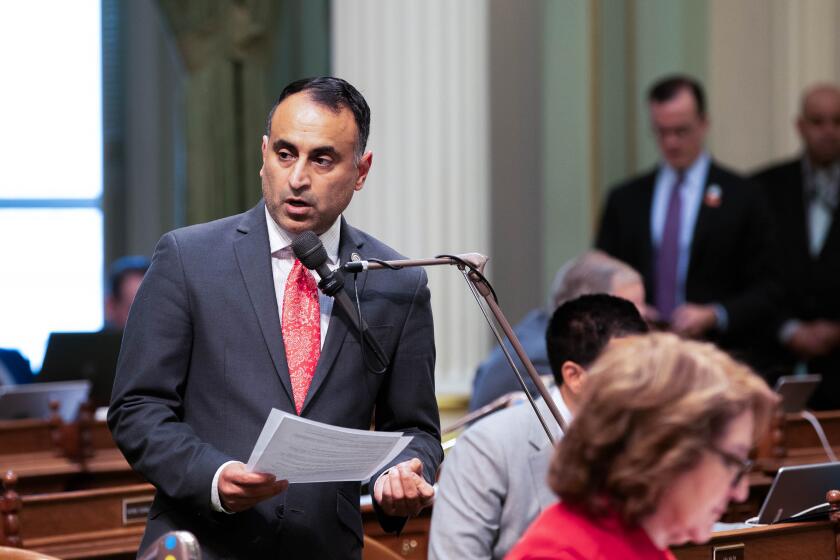Newsom campaigned for single-payer, but that’s not in his budget

- Share via
Close prisons. Give workers more paid family leave. Make preschool available for free to all 4-year-olds.
Those policies aren’t just fodder for Democratic campaign ads — they’re examples of how Gov. Gavin Newsom has used the state budget to advance a progressive vision for California. In his 2019 budget, Newsom added two more weeks of paid family leave for workers to bond with a new baby or care for a sick family member. In his 2020 budget, Newsom revealed plans to close a second prison. He used part of the surplus in last year’s budget to begin phasing in universal preschool.
So it was little surprise when Newsom released his 2022 budget proposal on Monday that he included another marquee progressive policy. This time, it was healthcare. But instead of wrapping his arms around the sweeping overhaul involved in creating a single-payer healthcare system, Newsom took a more pragmatic approach. He suggested expanding the state’s health insurance program for low-income Californians to include all undocumented immigrants, and creating a new Office of Health Care Affordability to develop ways to reduce premiums across insurance plans. It’s a liberal dream, sure, but not the same thing as a unified state-run system that covers everyone and removes profit-driven insurance companies from the healthcare business.
“California is poised to be — if this proposal is supported — the first state in the country to achieve universal access to health coverage,” he said as he presented his $286-billion spending plan in a Sacramento auditorium, sparsely filled because of the rapidly spreading Omicron coronavirus variant.
The governor’s plan lays out close to $10 billion in new spending on COVID, climate change, homelessness, inequality and ‘keeping our streets safe.’
Newsom could have taken the opportunity to acknowledge what his budget makes plain: that he’s moving away from the more radical approach he backed during his primary campaign four years ago, when he said “it’s about time” for Democrats to support single-payer. That won him the support of the left flank of his party as well as $500,000 in campaign support from the progressive California Nurses Assn. In the general election, when he was running against a Republican, Newsom moderated his message and said he’d like to achieve universal coverage including care for undocumented immigrants. Now, the governor is trying to have it both ways: suggesting something doable that the health insurance industry can live with, while saying he still supports systemic change.
The nurses union isn’t buying it.
“Reality has set in,” Stephanie Roberson, the California Nurses Assn.’s lobbyist, told me. “We got hit with a sledgehammer that he is officially abandoning single-payer as his way to move forward.”
Newsom’s proposal calls for expanding the Medi-Cal insurance program to all low-income undocumented immigrants. Currently, it’s available to those up to age 26 and over age 49. Extending coverage to the 764,000 people now left out would cost $2.2 billion a year when the program is fully implemented in 2024.
In many states this would be a contentious proposal because of Republican opposition. In Democrat-dominated California, the debate is more likely to focus on whether Newsom’s plan goes far enough. It’s a straightforward expansion of the existing healthcare system that builds on similar expansions the state has approved in recent years — not the kind of blow-it-up-and-start-all-over healthcare reform that Berniecrats have pushed for.
That vision is contained in a bill advancing in the Legislature that would abolish existing private and public insurance plans and cover all Californians with a new state-run single-payer system, called “CalCare.” Instead of fees or copays, Californians would pay for the system with billions of dollars in new payroll taxes, personal income taxes, and excise taxes on businesses. The complex plan would require approval from California voters as well as a new law from Congress because the state’s healthcare spending relies so heavily on federal dollars.
A proposal to bring universal healthcare to California, laid out in multiple pieces of legislation, faces significant hurdles in the coming months.
Newsom dodged questions about that proposal Monday as he touted his plan to give all Californians access to healthcare. But instead of saying he’s changed his approach to something that’s vastly more achievable — getting more people insured without overhauling the entire system — he dangled the possibility that single-payer could still happen.
He pointed out that a commission tasked with studying how to finance a single-payer system is due to release its report in a few months. He said he has appealed to the federal government for necessary waivers.
“The ideal system is a single-payer system,” Newsom insisted. “In the meantime, I’m doing what I said I was going to do, and that’s advance the cause of universal healthcare.”
The next day, Newsom took his show on the road, traveling to a clinic in Kern County to promote his healthcare proposal. He scheduled his news conference for the same time as the Assembly hearing on the single-payer bill. It was an obvious ploy to shift attention in his favor. No political novice, Newsom showed up at the press conference with progressive icon Dolores Huerta endorsing his plan.
The budget proposal a governor releases in January is always a starting point for negotiations. It takes buy-in from the Legislature to approve spending, and the art of politics — as well as the mechanics of state governance — demand that Newsom leave room for legislative leaders to play a role in shaping the plan that will be finalized in June. So the details of any healthcare expansion could evolve over the next few months.
But this is the last budget Newsom will propose in this four-year term. It’s his chance not only to set an agenda for the year and respond to the ongoing coronavirus pandemic, but also to fulfill campaign promises. The fact that his budget does not go all-in for single-payer shows he’s adjusted his ambitions. If only he’d just come out and say that.
More to Read
A cure for the common opinion
Get thought-provoking perspectives with our weekly newsletter.
You may occasionally receive promotional content from the Los Angeles Times.












